Create a welcoming space your clients will love — and you’ll never want to leave.
This post contains affiliate links. I may earn a small commission at no extra cost to you.
Why Cozy Matters in Therapy Rooms
When clients step into your therapy office, they’re bringing their deepest worries, hopes, and emotions with them. The space you greet them in isn’t just a room — it’s a reflection of the care and safety you offer. And when your office feels cozy, calming, and thoughtfully designed, you’re already helping them begin the healing process.
This post is your go-to guide for creating a cozy therapy room that feels warm, grounded, and beautiful — no matter your budget or room size. From lighting to layout, we’re covering 10 ideas that can instantly transform your space into a haven for emotional safety and professional presence.
1. Layer Soft, Warm Lighting for Instant Comfort

Nothing disrupts a cozy atmosphere faster than harsh overhead lighting. Instead, build your lighting in layers — blending floor lamps, table lamps, and wall sconces to create a warm, diffused glow.
How to Recreate It:
- Choose bulbs between 2200K–2700K (these give off a soft amber glow)
- Add a cordless or rechargeable table lamp if outlets are limited
- Position a floor lamp near the seating area, pointing light toward the wall for bounce
- Layer in fairy lights or LED candles for extra ambiance
Lighting changes everything. Instead of relying on harsh overhead lighting, build warmth by layering soft light sources throughout the room. Choose bulbs between 2200K and 2700K for a cozy, amber-toned glow that mimics late afternoon sunlight. This warmer spectrum of light is associated with reduced anxiety, lower stress levels, and a greater sense of emotional safety—key elements in a therapeutic setting. In contrast, cooler, bluish light (above 4000K) may be energizing and helpful in task-oriented environments like offices or hospitals, but it can feel overly sterile or alerting in a therapy room, making it harder for clients to settle in and open up. Warm light naturally supports nervous system regulation and encourages relaxation, making it ideal for deep conversations and emotional processing.
2. Choose Inviting, Curved Accent Chairs
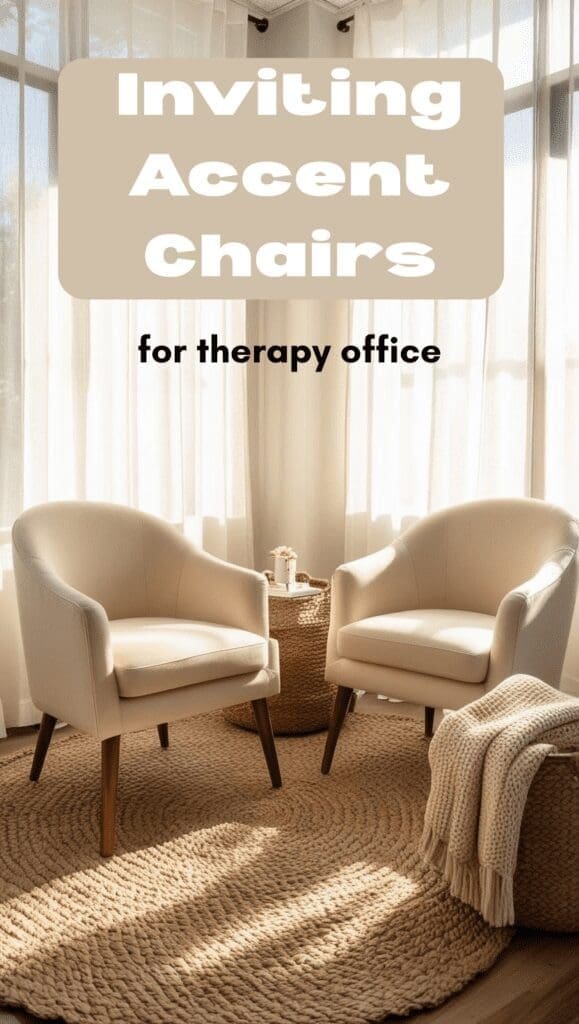
Seating is where your client will spend most of their session — make it feel like a hug. Opt for chairs that are curved, upholstered, and deep enough to relax into.
How to Recreate It:
- Look for bouclé, velvet, or linen-blend fabrics
- Avoid stiff-backed modern styles and instead choose rounded or barrel-shaped chairs
- Add a soft lumbar pillow and a textured throw in a calming shade like sage or oatmeal
3. Bring Nature In With Houseplants
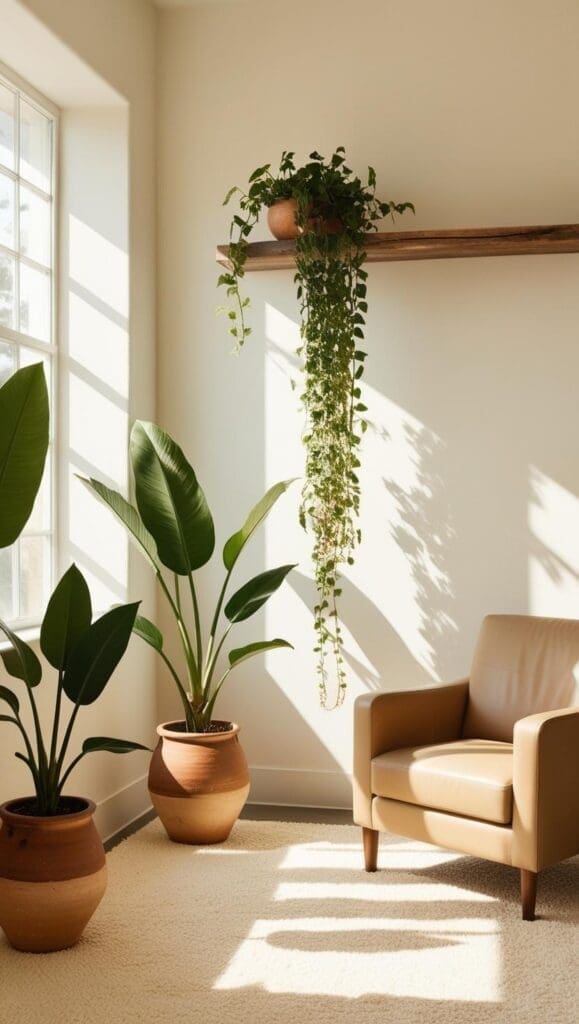
Greenery instantly softens a space and brings it to life. In a therapy office, even one or two carefully chosen plants can shift the emotional tone—grounding the energy, purifying the air, and offering a visual anchor that subtly encourages calm and connection. Nature has a regulating effect on the nervous system, and adding live plants to your office is one of the easiest ways to introduce a sense of peace.
If you’re not naturally a “plant person,” don’t worry—many beautiful options are extremely low-maintenance yet still make an impact. Consider:
- Pothos (Epipremnum aureum) – Fast-growing, elegant trailing plant that thrives in low light. Its vines can be trained to climb or cascade for a cozy, organic look.
- ZZ Plant (Zamioculcas zamiifolia) – Glossy, sculptural, and nearly indestructible. Tolerates neglect and low light while still looking polished.
- Snake Plant (Sansevieria) – Tall, upright, and architectural. It’s a great vertical element and also known for excellent air-purifying properties.
- Peace Lily (Spathiphyllum) – Lush and graceful, with occasional white blooms. Ideal for shaded corners and adds a soothing softness.
- Parlor Palm (Chamaedorea elegans) – A gentle, tropical feel that does well in indirect light and brings a classic coziness to any room.
You don’t need a jungle—just one plant near a chair or on a shelf is enough to add vibrancy and visual comfort. Choose a textured planter in a neutral tone to enhance the natural look, and let the greenery become part of the therapeutic atmosphere.
How to Recreate It:
- Start with low-maintenance plants like pothos, snake plants, or ZZ plants
- Use natural clay or woven planters to add texture
- Place a trailing plant on a floating shelf or window ledge for a relaxed vibe
4. Add Calming Wall Art With Meaning

Your walls aren’t just decoration—they’re a quiet form of communication. What you choose to display in your therapy office can say, “You’re safe here,” without ever speaking a word. Meaningful wall art helps establish emotional tone, personal values, and aesthetic warmth. It can also subtly support the therapeutic process by inviting introspection or calming the senses.
While you can always purchase beautiful prints, consider creating your own. Many therapists are now designing custom wall art that reflects their professional values, favorite affirmations, or therapeutic imagery. Tools like Canva or AI art generators (such as Midjourney or DALL·E) make it easy to develop serene abstract visuals or symbolic art that resonates with your work. You might even transform your personal mantra, a favorite grounding phrase, or therapy-themed symbol into a minimalist art print.
If you’d like to explore curated, therapist-inspired pieces, I’ve created a collection of calming, thoughtful wall art designed specifically for therapy spaces. These prints are available through my Redbubble store and can be ordered in various sizes and formats—from framed prints to posters to canvas. Each piece is intentionally created to bring warmth, inspiration, or a moment of mindfulness to your walls.
Shop calming wall art for therapists on Redbubble →
When displaying your art, try grouping it in twos or threes for visual harmony, and use natural wood, gold, or black matte frames to elevate the look. A well-placed print—whether it’s a peaceful abstract or a simple quote—can quietly support the healing energy of your space.
How to Recreate It:
- Select art with soft, natural tones — think watercolor leaves, quiet mountain scenes, or minimalist line drawings
- Use natural wood or gold metal frames
- Hang in small groupings — a gallery wall of 3 works beautifully above a sofa
5. Use Textured Rugs to Anchor and Warm the Space

Rugs bring physical and emotional warmth. They ground the room and quiet footsteps — perfect for creating a peaceful setting.
How to Recreate It:
- Choose a large rug that extends under both chairs or seating areas
- Prioritize texture: go for wool, jute, or washable plush
- Layer a sheepskin or patterned runner for added dimension
6. Create a Comfort Nook for Emotional Grounding
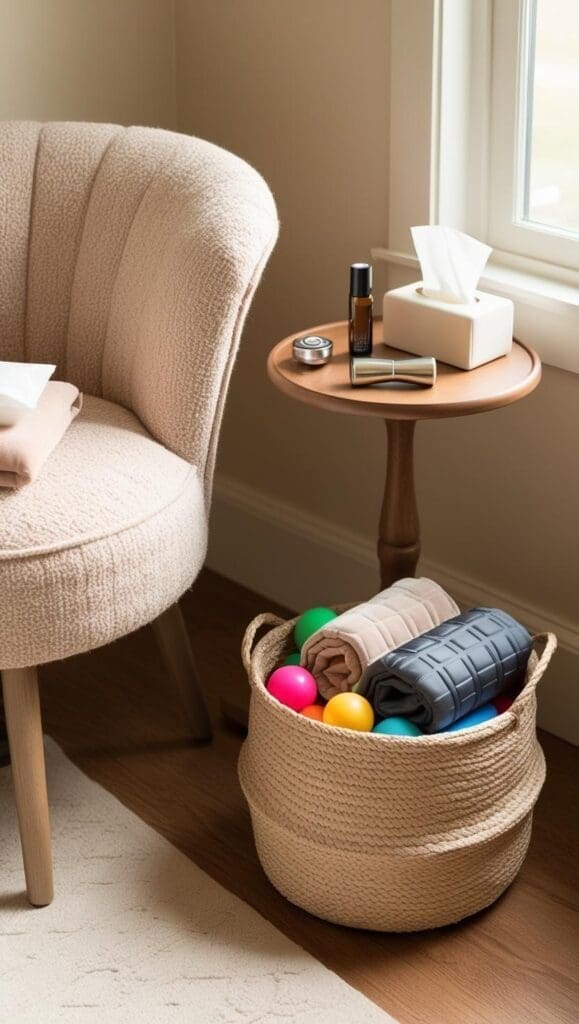
Therapy isn’t always easy. A small corner with self-soothing tools can make a huge difference, especially for anxious or young clients.
How to Recreate It:
- Include a weighted blanket or lap pad
- Offer fidget tools, tissues, and aromatherapy options
- Display everything in a soft woven basket or tray for easy access
7. Stick to Earthy, Soft Color Palettes
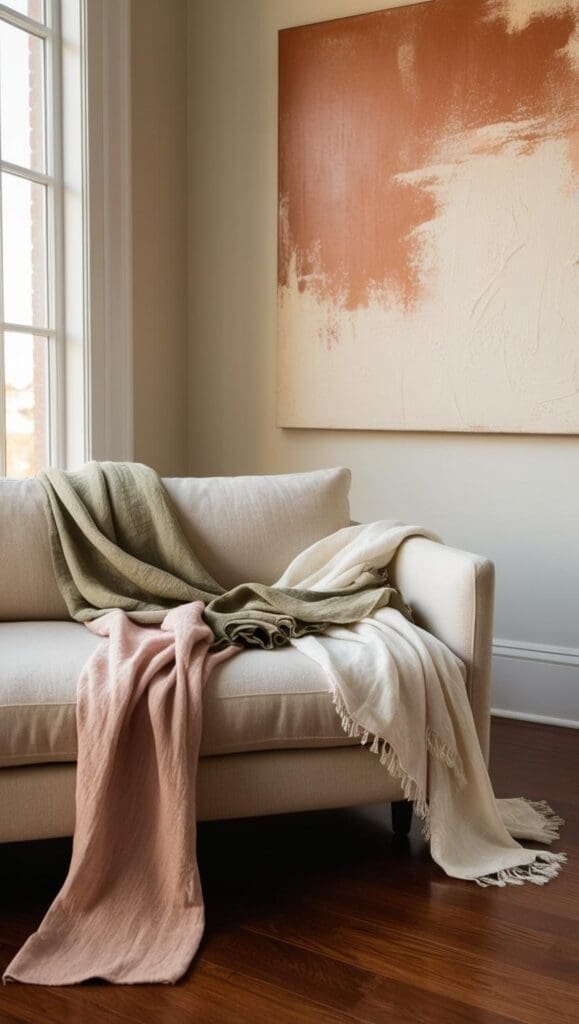
Color psychology plays a powerful role in how a space feels. In therapy offices, earth tones promote a grounded, cozy atmosphere without overwhelming the senses.
How to Recreate It:
- Start with a base of warm neutrals (cream, beige, sand)
- Add color accents like olive green, soft rust, or dusty rose
- Bring in these shades through pillows, throws, artwork, or planters
8. Incorporate Calming Scents (Gently)

Our sense of smell is directly tied to emotional regulation. Subtle aromatherapy can promote calm, but it’s important to keep it client-sensitive.
How to Recreate It:
- Use a ceramic or woodgrain essential oil diffuser with calming oils (lavender, cedarwood, or bergamot)
- Always offer scent-free sessions upon request
- Avoid strong candles — instead opt for flameless ones with vanilla or unscented wax
9. Hide Visual Clutter With Smart Storage
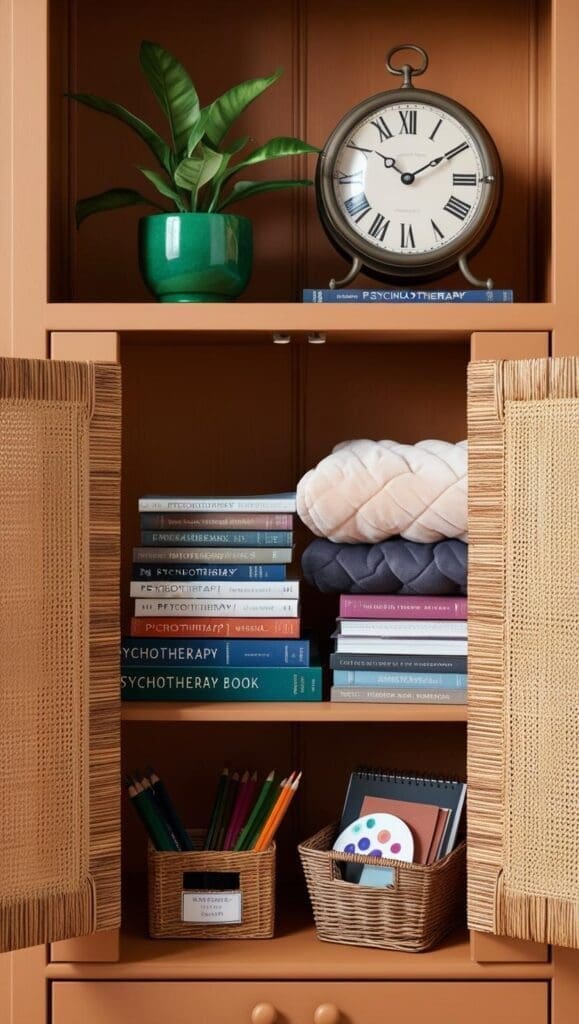
A clean space helps clients feel more in control and less overwhelmed. But in therapy offices, storage has to be practical and attractive.
How to Recreate It:
- Use closed storage for books, worksheets, or client tools
- Style baskets or bins on open shelving for a natural look
- Keep surfaces clean but styled: one tray, one plant, one candle
10. Design a Living-Room-Like Waiting Area
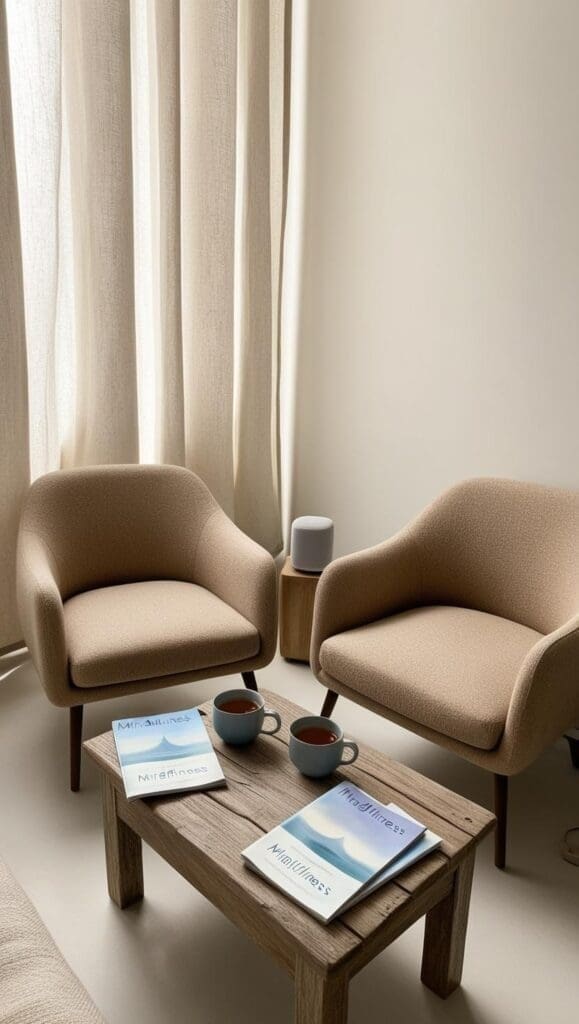
Your waiting room sets the emotional tone before the session begins. It should feel like an extension of your therapeutic presence — safe, relaxed, and human.
How to Recreate It:
- Use soft seating, not stiff lobby chairs
- Offer cozy touches like a magazine stack, throw pillow, or mini beverage station
- Add neutral wall art, a soft playlist, and a plant or two
Final Thoughts
A cozy therapy room isn’t about perfection — it’s about presence. It’s about creating a space where vulnerability can exist safely. With thoughtful choices, textures, and color, you can turn even the smallest corner into a refuge.
Whether you’re starting from scratch or simply adding a new plant or lamp, these ideas will help you shape a space that speaks gently and listens loudly.
Your office can feel like home. And your clients will feel it, too.
For a full office makeover plan, see this article

About the Author
Hi, I’m Eve, a former school counselor with a master’s degree in School Psychology and a passionate advocate for children and families navigating sensory challenges. As a mom of children with sensory sensitivities, I deeply understand the journey special-needs parents face, and I dedicate myself to researching and sharing practical solutions to help children thrive and feel comfortable in their bodies. My goal is also to empower counselors, therapists, and psychologists with creative strategies and supportive resources to enrich their everyday practice. When I’m not writing or exploring new therapeutic approaches, you’ll find me spending quality time with my family and continually seeking inspiration from everyday moments.

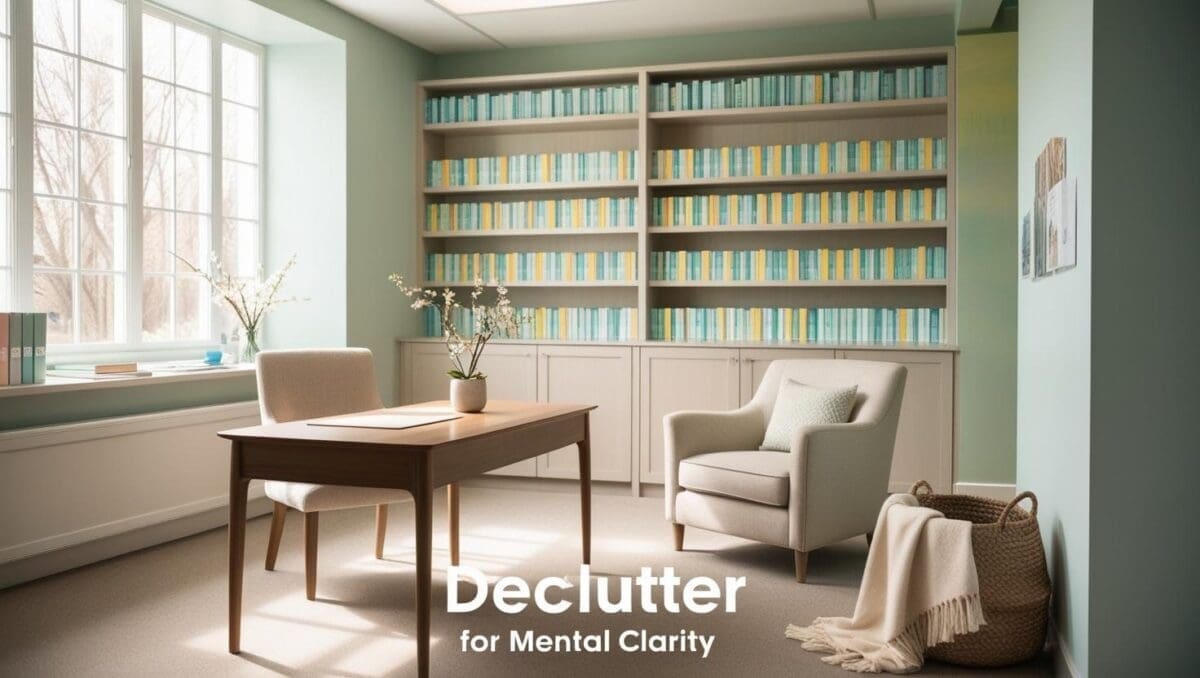

Pingback: Calming Therapy Room Design Tips That Actually Work - EveYou